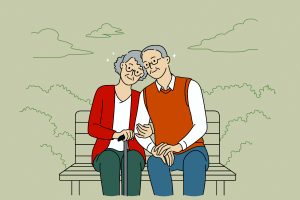The first couple of years in retirement are often the most difficult. But they also can set the stage for how you’ll fill the years ahead—both financially and psychologically. Stephen Kreider Yoder, a longtime Wall Street Journal editor, joined his wife, Karen Kreider Yoder, in retirement in late 2022. In this monthly Retirement Rookies column, the 67-year-olds chronicle some of the issues they are dealing with early in retirement .
Steve
We were cycling along the north Japan coastline in July when a reader sent us an email we’ve been talking about ever since.
“We traveled a ton the first two years of retirement and then stayed home for the last 6 months for the first time in our lives to just be in our neighborhood, in our home, our garden,” wrote Colleen, 64, of Washington state. “It’s been so much more enjoyable than we thought.”
Colleen’s words struck a chord because Karen and I had been wondering aloud, as we pedaled, whether it was time to settle down a bit at home when we got back at summer’s end. “Maybe it’ll be time for a reset,” I said more than once.
We’ve spent nearly half of our days away since I retired. We regret none of it, whether biking across America, exploring the Algerian Sahara or riding Amtrak to see Dad in Iowa. Japan’s Hokkaido island enriched us beyond expectation as we rode among fishing villages, up mountain roads and through farmland where I spent my childhood.
Yet with each kilometer forward this summer, we found ourselves yearning a bit more to just be home—and not just as a break between trips.
We’re back now, and still determined to stay. But for me that means admitting I haven’t figured out how to be retired at home yet. One of my biggest discoveries since quitting work has been how hard it is for me to get off the couch and find stuff to fill the vacuum where my career used to be. The emptiness of a blank slate is daunting.
For decades, my job set much of my daily agenda. Tasks rushed at me unbidden at every turn, requiring creative decisions that often brought gratifying outcomes. The steadiness of the onslaught was addictive, I can see now.
Travel can be a similar drug. Whether I’m navigating an unfamiliar country or a winding Appalachian byway, the journey bombards me with new tasks every hour. The road decides what decisions I must make.
Back home, the onus is now on me to go out and find tasks, and I’m not good at that. I putter in the garage, fix things around the house, read a bit, ride in the park with Karen—then inevitably begin pulling out maps to dream up another trip as if I need to escape.
So I’m trying to imagine my own retirement with less travel, one where home is a nest to settle into rather than a coop from which to plan the next flight out. Part of that is telling myself it’s OK not to be productive in the workaday sense, that I deserve to linger at home over books or music or tinkering tasks that are just plain fun.
I have plenty of role models. A friend recently retired and immediately adopted a fulfilling routine of gardening, pickleball, bowling and visiting grandchildren. Others have found part-time editing work that seems to provide purpose and a comfortable routine.
I especially envy Karen. From the day after she retired, she has been able to fill her days at home and in the community with gratifying activities that help enrich others. She’s eager to travel, but just as happy to resume her retired-at-home routine.
We’ve been trying to invite more people into our home, now that we have more time. Becoming comfortable at home also requires getting out locally, I’ve concluded. So I’ve begun signing up for more volunteering and am considering getting part-time paid work, not so much for the money but to add some outside structure from which to come home. A longtime friend, retired, works part time in the bike department of a sports store—that sounds awfully attractive.
But I might be incorrigible. Last month, I secretly ordered 12 maps that cover a bike route across the American North. They are under my desk as I write, calling softly to me.
Karen
Home again, home again, and there is so much I get to do, now that I’m retired.
Too much, sometimes.
In the first week back from Japan, I emailed friends living within walking distance. The list grew to 20, not including children.
“Ready to connect with y’all,” I wrote. “Want to join us on a bike ride to the beach?…Want to come over and sit on the stoop in the late afternoon?” Immediately, a friend invited us to a debate-watching party and another proposed a neighborhood potluck. We biked to the beach with a new neighbor for a moon-watching celebration. I lent my big pot for a friend’s shrimp boil.
Unlike Steve, I don’t spend a lot of time agonizing over how to define my new place in life when we aren’t traveling.
Being at home is calming. I wake early, make coffee and putter alone around the house. I unload the dishwasher and read the San Francisco Chronicle in print. I do a few word puzzles and text the results to my sisters.
All before rise of sun or Steve.
Being at home is a joy. I cook up meals to share with friends. I dehydrate apples and grapes. I make plum jam and quince butter. I sew comforters and make quilts. There’s always a big project going—scanning photos, sorting files, making sock monkeys, hosting my women’s group, tutoring an adult learner.
My professional life, like Steve’s, once set much of my daily agenda. My retirement life is a job, this time one of my own choosing.
My struggle: I tend to choose “yes” too often and I often feel constricted by all the tasks on my list, even though I enjoy doing them.
One solution: I list all the tasks with a time allocation, and they seem more finite, more doable. Finish childhood fabric quilt—20 hours. Childhood files—8 hours. Create photo books for three sons—15 hours before Christmas.
And I made a pact with myself. Spend the morning doing what I need to do—paperwork, errands, tasks I tend to avoid. The afternoon is for doing what I want to do, like sewing, reading and cooking and biking.
Then there are the regular weekly activities that I’ve chosen—Tuesday morning meditation on Zoom, Tuesday evening dinner and comforter knotting, Wednesday morning biking to pick up our community agriculture box. Thursday once a month is Serendipity Day with Steve, when we draw a slip of paper out of a jar with an activity written on it.
Those activities sprinkled in make for regularity and consistency across the week.
And when all my activities begin to feel like too much, I can count on one predictable reset: travel. When we leave for a month or more, I put things on hold—and come back to them with renewed enthusiasm.
It will be probably some time next spring that I need the next reset, a good season to start off across the country again. Now that Steve has confessed to buying those Northern Tier bike maps, I’ve already started researching campsites along the route.
The Yoders live in San Francisco. They can be reached at reports@wsj.com .










